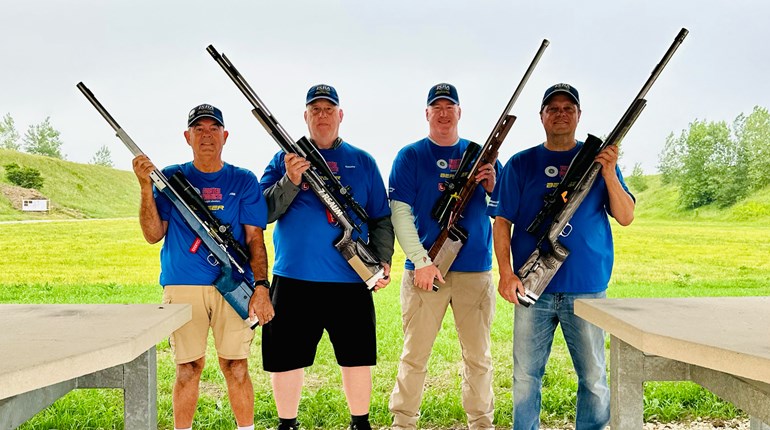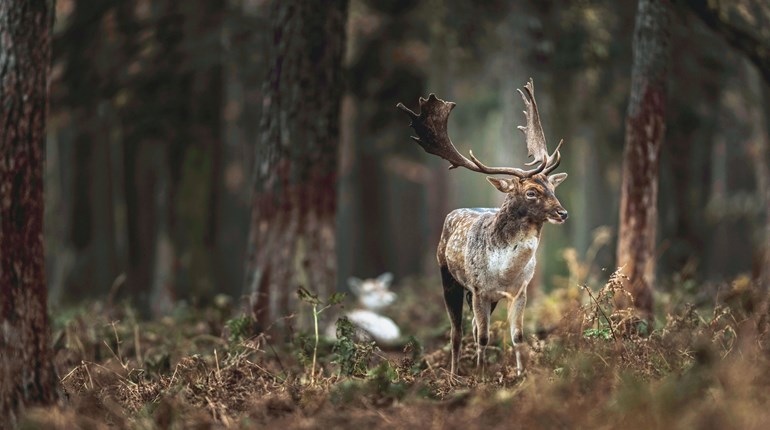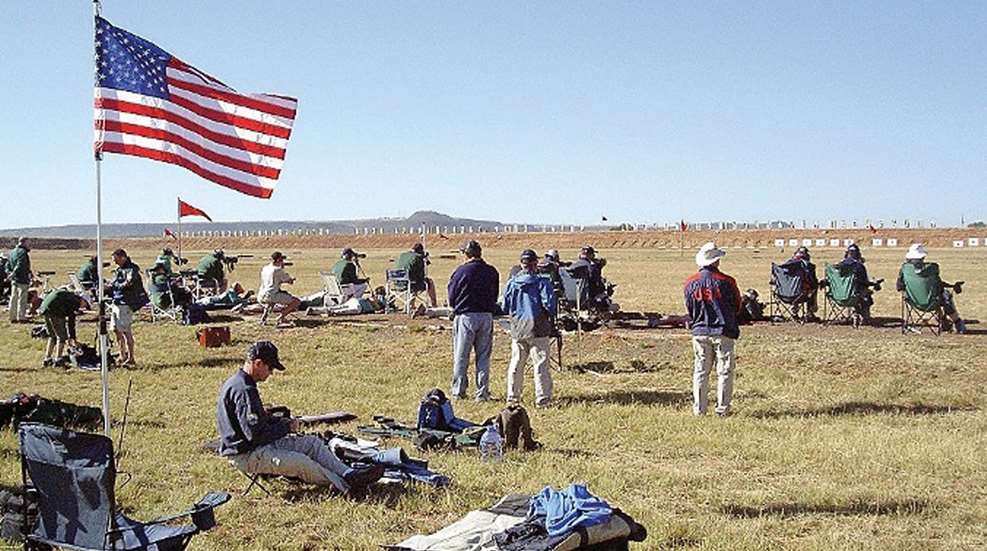
From the vault: U.S. Development Team member Anette Wachter shares an insider view of what it means to travel and compete in an international match—from 900 meters—with this article about the U.S. Rifle Team competing in South Africa in 2013. Originally published in the August 2013 issue of Shooting Sports USA.
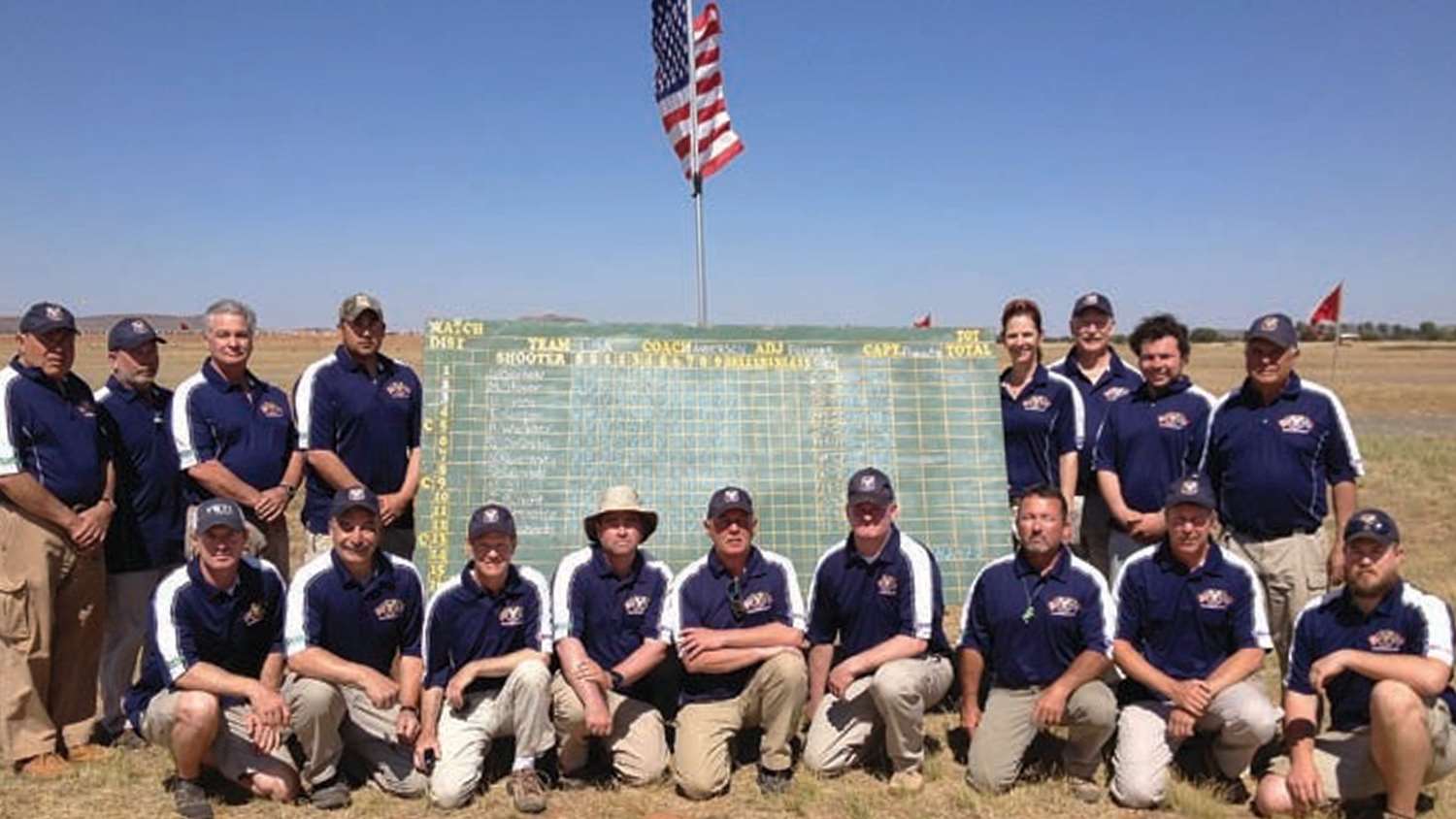
About 24 U.S. T/R shooters, including me, made the journey to Bloemfontein, South Africa (SA), for the 77th SA Open Bisley Championships. Another 15 U.S. F/TR and Open shooters came as well. The match took place over two weeks and combined individual with team events. The South Africans hosted countries including Australia, England, Ireland, New Zealand, the U.S. and Wales. And for the first time ever, the America Match was held in SA. The SA Open Bisley Championships have three disciplines defined by their equipment. The first are the Target Rifle (TR) shooters who are limited to either a .223 Rem. or .308 Win. cartridge with 156-grain bullet, iron sights and a sling.
The F-Class Open Rifle (FO) competitors can use a rifle restricted to a bore diameter no larger than .35 caliber, a front rest and a rear bag for support. In the third group are the F-Class Target Rifle (F/TR) competitors who are also limited to the .223 Rem. or .308 Win. cartridge but with any bullet weight. They are also allowed a front bipod and a rear bag on which to rest their rifle. European teams fire a fourth category called .303.
“Rifles must be standard .303 service rifles which were at some time issued to British Empire or Commonwealth armed services. Only .303 cal. 174-grain MK VII Ball ammunition, or the hand loaded equivalent thereof, is permitted.”
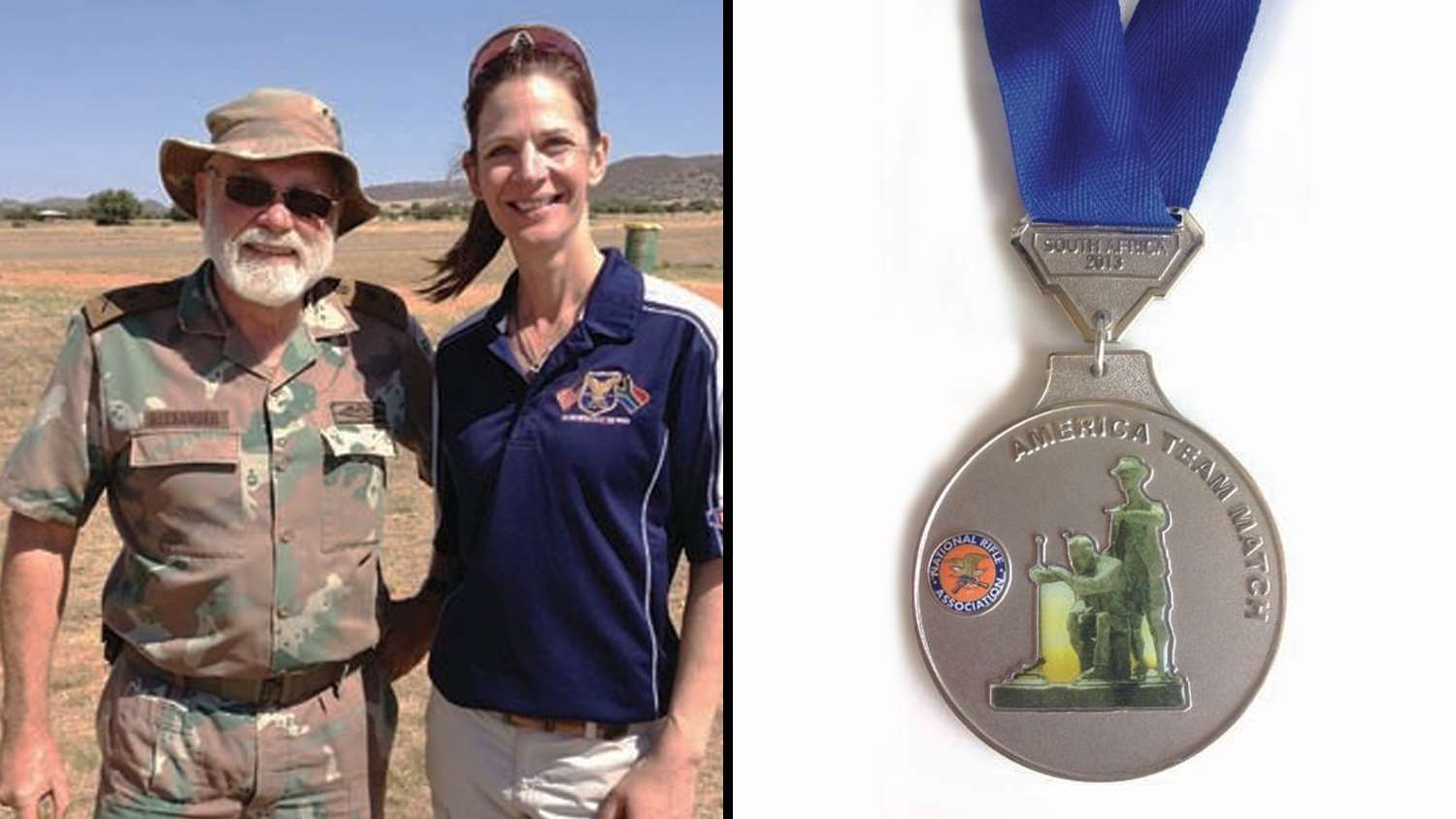
A great turnout of approximately 300 shooters took over the General de Wet range—an Army base in Bloemfontein. Located four hours south of Johannesburg, Bloemfontein is a huge farming area. The locals there are rugged, blond-haired, blue-eyed people who really know how to shoot. The town also houses the stadium built for the 2010 World Cup (soccer, not shooting). U.S. shooters from all over the country flew into “Joburg” on the 31st of March. Thanks to our very organized rifle permit agent, she was able to get everyone and their rifles through Customs without a hitch. What a scene that was—30 or more rifle cases stacked in the middle of the airport. With six rental vans waiting for us, we loaded four people and a walkie-talkie into each vehicle and started our caravan to Bloemfontein. Thank goodness the modern GPSs worked and got us out of Joburg to the highway. Many years ago, the team got lost within the city and it was not pretty. The most adventurous part of our road trip was trying to get the gutless vans up to speed in order to pass slower trucks. Then there was the challenge of making sure all six vans made the pass each time. As you can imagine, there were some entertaining comments on the walkie-talkies along the way. We made it safely to our Southern Sun Hotel near the edge of town.
It turned out the British team was also staying at this hotel so, between the two groups, we took over the place. This was also the hotel for professional soccer and rugby teams playing at the stadium, so we had fun interacting with them during our stay.
As soon as we arrived, our team captain and coaches went straight to the range to pick up our ammunition. As part of their sponsorship of the U.S. Rifle Team, Sierra Bullets shipped everyone’s personal ammo to SA. We loaded the ammo, sent it to Sierra (about 500 rounds each) and they somehow got it over there. We could not have done it without them. Reunited with our ammunition, we prepared for our first day of shooting the next morning. We purposely arrived two days early for practice and to acclimate a bit. The drive to and from the range each day brought us sightings of giraffes, zebras and occasional herds of springbok or wildebeest.
Every morning to start the match he would read a passage from the Bible and say a prayer. Imagine Sean Connery with his silky, commanding voice booming over the loudspeaker.The entire match was directed by the most interesting man—General Mac Anderson. If you Google him, you will find out amazing stories from his life. He has written a book. He had a tragic family incident with terrorists, and yet his religious faith kept him strong and actually saved their lives. And he has a voice like God. Every morning to start the match he would read a passage from the Bible and say a prayer. Imagine Sean Connery with his silky, commanding voice booming over the loudspeaker. He deserved respect. It was awesome.
The America Match was held first. Our eight-member team had to be decided during the two previous practice days and, because this was the first time it was to be held in SA, it was a big deal. The America Match was held in 2012 at Camp Perry and the U.S. won the trophy. We wanted it again. First shot in 2002, the America Match can only take place when an official U.S. team is present and competing. The intent is to hold the match every two years, although other countries may apply for the match in odd years as did SA for 2013. In 2014, Canada will host the eighth occasion of the match—the fourth time it will be shot in Canada. That will also be the final round of tryouts for the 2015 U.S. Palma Team.
Considering that I am still a rookie on the U.S. Development Team, I was not expecting to make the squad of eight for this America Match. Well, I was chosen. Talk about nervous! The U.S. team had Norm Anderson as head coach, with Emil Praslick (former head coach of the AMU) and Steve Harding as assistant coaches. The shooters were myself, Lane Buxton, Brandon Green, David Crandall, Nate Guernsey, Ty Cooper, Michael Storer and Bob Gill.
Going straight in to the biggest match of the Championships when we still had not completely acclimated to the time difference, high altitude and heat was going to be interesting. Although entertaining, there was also the distraction of the occasional meerkat seen through the spotting scopes, or ostrich roaming across the range.
The morning of the America Match was sunny and warm with decent but tricky wind conditions. The match was shot at 300, 600, 800 and 900 meters. International targets use a V-bull and 5-, 4-, 3-, and 2-rings, instead of the X-ring with 10-, 9- and 8-rings used in the United States. In case you’re wondering, the V-bull center ring on a 300-meter target is only 2.5 inches. Tiny! Somehow, I was able to calm my nerves for this first match. I needed that. This match was a big deal and I wanted to perform well. I was squadded last in the lineup; a.k.a. the “clean up” position. Even more pressure. By the time I got up to shoot, I was the last one left on the line. That, and having a public score board behind the shooters where everyone can see the results as they happen, which was quite intimidating. Brandon Green and I tied for high scorers on our team, each with a 296-31V.
The South Africans took a big lead right out of the gate. No team ever caught up with them, and SA won by 16 points. The U.S. won the silver, nine points ahead of the Brits. We had four more team events throughout the two weeks, and the U.S. brought home several medals.
The next match—The Hamilton Cup, brought our six-person team a gold medal. Coached by Steve Harding, USA’s Team-B (myself, Brandon Green, Ty Cooper, Lane Buxton, Bob Gill and Norm Anderson) fired a smoking 627-61V, dropping only three points. The second match, which also included the aggregate of the Hamilton Cup, was a club match called The Rhodes Cup. This was the long-range portion at 800 and 900 meters. USA’s Team-B took sixth.
Next was the RSA International 12-member team match that was shot at 800 and 900 meters. Because the South African shooters pretty much owned the matches throughout the two weeks, I named them “Windjas” (Wind plus Ninjas). The range fl ags were blowing straight out on the day of the RSA—12- to 15-mph or more. Because the range uses canvas flags instead of the light nylon variety used in the U.S., the wind values were accurate. Not only that, but it was blowing directly at us from 12 o’clock with wicked switches. The South Africans fired an amazing score for this event. No one caught them. We held in there and received a bronze medal, while the English took the silver.
The Dewar match was another six-person event from 500 and 600 meters. Again, USA’s Team-B did well and took the silver. The overall Team Grand Aggregate reflected a bronze medal for the U.S team.
... we fought hard and were well-coached. We learned a lot as a team and took away new ways to approach strategies for future matches.
Named after a local South African flower, the Protea International Match was held on the last day of the championships. Besides our charismatic match director, my most memorable moment of the entire two weeks was the statement given to the team the night before the Protea match. As usual, we gathered for a meeting to discuss the lineup and strategies. Dennis Flaherty, our team captain, and Norm Anderson, our head coach, made their statements and then looked over at Coach Praslick for any last words. At first he declined, then suddenly burst out with: “If any of you even touch your rifles tonight or, especially, clean them, I will wear your face as a ski mask!” This had to be the best quote I’ve ever heard. I still chuckle about it. I took him seriously, but that was just funny.
Rain and thunderstorms were predicted for our last day but it managed to stay clear for us. England, Ireland, SA, the South African provinces, the USA and Wales were the countries competing. The range was set for 300, 600 and 900 meters. These are the most difficult lines on the range because they use the smallest targets. I felt we lost too many points at the 300—five as I recall. Both the Brits and SA dropped only three points. Back at 600 we caught up and shot very well. The winds were up and tricky at all meter lines. So it was up to the 900 line to tie it up. We were neck and neck with SA and England. But in the end, we were three points down from SA, and England was one point above us. A three-point match! What a heart breaker. But we fought hard and were well-coached. Our team walked away with new strategies for future matches.
And let’s not forget the individual portion of the championships. Congratulations to England’s Parag Patel who was the Bisley Champion. Patel has been on the Queen’s List (an aggregate of several matches throughout the year) both at Bisley and in England. There was a strong showing of U.S. names on the top-50 leaderboard. During the final awards ceremony, they set up 10 chairs for the top 10 shooters of the aggregate. Our own Lane Buxton (Sacramento, CA) was in chair number five. The other Americans on the top-50 list were Nancy Tompkins, Nate Guernsey, Brandon Green, Ty Cooper, Norm Anderson, David Crandall, Bob Steketee, Bob Gill and young Michael Storer. I was 67th out of 238 target rifle shooters and I’m okay with that at this point in my shooting career. USA’s Mike McGill placed seventh among 29 Open shooters, and our own Darrell Buell took second among 41 F-T/R shooters.
Some standout performances came from our youngest team member, Michael Storer (Enumclaw, WA). Twice, Storer not only cleaned the string, but had a "full house" of V bulls.
The South Africans put on this international event every four years or so, inviting as many countries as can make the journey. My experience during this trip exceeded expectations. Their hospitality was wonderful—they worked hard to put on a great match.
After the match I drove through Cape Town and north to Botswana and Zambia—an amazing experience. I look forward to four years from now, but, for now, the team and I need to focus on the next two seasons of Nationals: Ottawa in 2014 for the next America Match, followed by the Palma World Cup in 2015 at Camp Perry.













